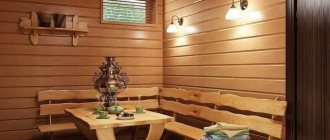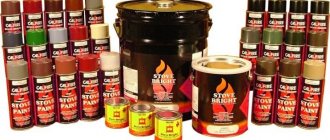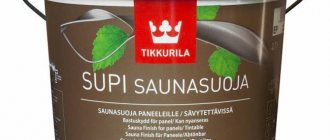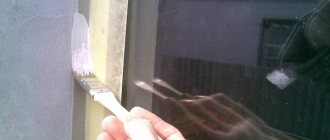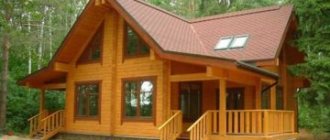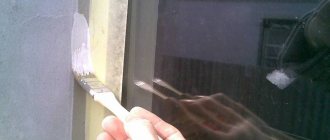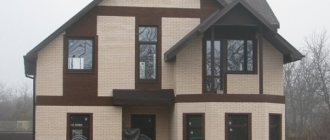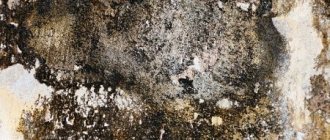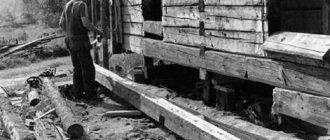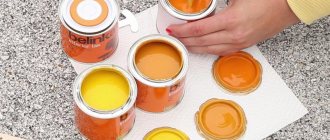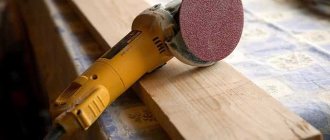In principle, it is advisable to think about the need to protect any lumber from rotting at the stage of preparation for construction.
But for a number of reasons, it is not always possible to pre-treat the timber. Consequently, this has to be done on a ready-made bathhouse, both inside and outside. Let’s analyze which preparations are best used for treating a log bath and what to consider when purchasing and during work. There are opinions (and not isolated ones) that if timber that has already been processed at the enterprise is purchased for a bathhouse, then its additional impregnation is nothing more than a waste of both money and time. Such statements are not entirely true, since during the installation process one has to deal with sawing and adjusting samples.
In addition, the manufacturer, trying to reduce the cost of production, saves, among other things, on special products for wood processing. Therefore, this measure to protect the building material should be carried out in any case, especially when building a bathhouse.
Water-based polyurethane varnishes
When thinking about how to impregnate the inside of a bathhouse, you can pay attention to these new products on the market. They contain resins, water and solvents. They are not afraid of temperature or salt. Such varnishes are distinguished by the absence of cracks and peeling even for a long period of time after application. A relative disadvantage is the high cost, which is offset by its undeniable advantages - versatility for all rooms, ease of application and high performance characteristics.
Compositions
Many people will immediately answer that there is no need to treat it inside at all , because there is “chemistry” everywhere, and it is always harmful, especially in a bathhouse.
If we understand by “chemistry” artificially obtained organic compounds, then yes, many of them will not bring anything good to living organisms if they get inside. But, excuse me, we ourselves also consist of organic compounds, and we eat them too. You just don't have to ask the question like that. A steam room is a place where elevated temperatures make various substances more volatile. These are the smells of herbs, and resins in wood, and phenols in mineral wool... In general, if you smell the smell, it means something has warmed up and is “phoning.” It’s bad when paint or varnish, or PVC, or mineral wool, or sulfides in stones begin to “sink.” Therefore, they try not to put plastic in the steam room; for insulation they use only those heat insulators that do not release binding substances when heated (if mineral wool, then with a mark on the packaging “for saunas and baths”)...
IMPORTANT! They also refuse to use varnishes and paints based on organic solvents.
But the modern paint and varnish industry has already taken a technological step towards greater humanity and environmental friendliness. Now there are water-based varnishes and paints that practically do not smell when applied , and after drying they form a fairly durable polymer that does not smell of anything at all.
Therefore, the Finns, knowing perfectly well what temperature conditions they have in their steam rooms, make and sell compositions that have been tested and are considered safe. These are water-based acrylic coatings. Or they are impregnations made from completely safe oils - linseed, paraffin...
However, don’t even let the paint harm your health with its smell, it reacts quite poorly to moisture, tends to peel off, hang in rags... Therefore, if you paint the steam room in a bathhouse with anything, then only with special compounds that are suitable for bathrooms ( also written on the packaging ). Such coatings are waterproof.
Lucky
After all, natural wood in a steam room is such a built-in standard.
Therefore, somehow the thought does not arise about paint that will hide the texture of the wood. And there is no need - now you can tint the varnish with any color - be it green or pink. Let’s think for a second about why we should even look for varnish for the steam room in the bathhouse. Wood that is heated and moistened undergoes deformation - it gains moisture, swells, then contracts in volume, and often cracks after this. And if it fails to dry properly, fungi and bacteria take advantage of this, converting the cellulose into rot.
So, coatings such as varnish are not so much for beauty as for protection - from cracks and deformations, from mold.
You can protect the floor by using waterproof yacht varnish. Even though it contains polyurethane or urethane. The thing is that the temperature on the floor in the sauna is low - the Finns are required to have a 5-10-centimeter gap under the door to the steam room.
In a Russian steam room, if you don’t make special heated floors, it’s also not that high, it’s unlikely to be higher than 30 degrees. Therefore, yacht varnish will not hurt here either.
Waterproof, highly abrasion resistant varnish will make the floor more durable. Just don’t allow a problem like the one in the video below.
The walls can also be varnished, but this time it is safer.
ATTENTION! This can be any acrylic varnish that clearly states that it is intended for sauna walls.
Such varnishes are available from different manufacturers - both Russian and foreign. Teknos, Belinka, Tikkurila, Dulux have them, as well as ours - Neomid, Senezha, Rogneda, etc. If there is a certificate, it means the product is good.
Oils
When they talk about “oil for a steam room in a bath,” they mean impregnation for wood, but not drying oil . Compositions have long been developed that do not smell like drying oil. In particular, there is no smell from paraffin oil.
Treatment of the bathhouse inside the steam room with oils is usually limited to covering the shelves with them. This is done because it is the safest way for humans to protect the tree.
On sale you can find both liquid oil compositions and more solid varieties containing, in addition to oil, also beeswax. The latter are even better, considering that wood has been waxed for a long time, and not only for a beautiful shine, but also to increase its service life and protect it from all kinds of pests.
Impregnations with wax
They have a long history of use. More often than not, wax is an auxiliary component. Treatment advantages:
- excellent surface gloss;
- preservation of the natural texture of wood;
- protection of wood from darkening due to antioxidant effects;
- reliable protection against water and steam.
Due to the viscosity and thickness of impregnation with wax, it is difficult to apply, but they are durable, do not accumulate dirt, and do not create a sticky layer. Used on all surfaces, perfectly protects against moisture and steam.
Which are the best for outside treatment?
Let's start with the outside. It can be made of wood in two cases: when the wall is made of wood - timber or round timber, and when it is lined with wood. In this case, either clapboard for external cladding or board can be used.
Bathhouse with a large relaxation room
As for impregnations, they are divided into two categories: for protection against biological damage (antiseptics) and/or fire retardants and for protecting wood from the effects of nature and weather (coatings).
The antiseptic agents that are used to impregnate the outside of the bath will not differ for boards and logs, because in our case they are all intended for manual application . This means that their depth of penetration into wood is limited to a maximum of 5 mm, but in reality it is even less.
Therefore, it is advisable to approach the impregnation of bathhouse timber more responsibly and use stronger antiseptics.
For log and timber
Ideally, for the outside of a log bathhouse, impregnation made in an industrial environment . But it covers the entire surface layer of the log, which is not good for a steam room if it is not insulated and lined with clapboard. If the walls are covered (only in the steam room), then impregnated wood should be considered the most protected from rot and mold.
You can read in detail about what it is and what compounds are used there.
Applying antiseptics manually, as already mentioned, is less effective, but fairly strong formulations can be used.
IMPORTANT! The lower crowns and window sills are the zone of greatest moisture during precipitation, and therefore rotting most often begins there. They can be protected with strong, non-washable antiseptics intended for use of wood in difficult conditions (specifically high humidity).
In general, it is recommended to pay attention to those compounds that are designed for outdoor use.
An example of a good option for impregnating the outside of a log bathhouse is the “Valtti” . They are sold with an antiseptic primer. Ideal compatibility option.
ADVICE! If you choose between oil paints and acrylate compositions, choose acrylates, but if you choose between oil impregnations and acrylates, then both are good.
Let me explain. to peel off after three years in the harsh Russian winter Oil impregnations are better in this regard because they form a more elastic coating. The same applies to acrylate compounds.
Actually, here it is. We coated the wood with an antiseptic, after which the impregnated layer must be protected from washing out and destruction by ultraviolet radiation. Therefore, pay attention to the presence of UV filters in the product you will use to coat the antiseptic.
What is good about exterior impregnation of a log house with oil? Thanks to it, the logs will crack much less , because the oil makes the wood less fragile. In our opinion, this is the best impregnation for the outside of a bath. You can use both domestic and imported oils. The main thing is that they are intended for facades, contain UV filters and are resistant to temperature changes and precipitation.
RESULT: it is good to use strong antiseptics at least for the most vulnerable parts of the log house, but you can cover the entire facade with them. It is good to apply a layer of facade oil on top of the antiseptics.
Differences between oil and water soluble products
Since these two products are based on different substances, their properties differ significantly. Acrylic-based products have gained great popularity due to:
- universal scope of application, as they are suitable for log houses outside and for lining or timber inside;
- lack of smell and color;
- availability in dry form for cooking and ready-made for immediate use in work.
However, the water they contain, although it provides easy application and deep penetration, leads to leaching, which requires frequent reapplication.
Oil products differ:
- ability to penetrate deep layers;
- formation of a film, but maintaining the ability to pass air;
- durability;
- maintaining properties even under increased loads.
At the same time, they have a pronounced unpleasant odor and toxic effects due to the solvent.
Important! It is necessary to carefully study the composition and exclude the presence of harmful, dangerous and aggressive substances.
Useful video
An advertising video listing the entire range of paint and varnish products that could be used to treat a steam room in a bathhouse:
***
You may also be interested in materials about the steam room, where we talk about finishing the steam room and separately about finishing it with your own hands, about insulating the steam room, and electrical wiring in it. And for those who are just starting to build their own bathhouse, it will be useful to learn about the structure of the steam room, its design, the layout of the bathhouse as a whole, the ergonomics of the steam room and its optimal size.
Choosing paints for concrete floors
There are four types of paints used to paint concrete floors: acrylic, epoxy, acrylic-silicone and alkyd-urethane.
Acrylic
Such paints are resistant to water and temperature. Paint for concrete floors makes the surface matte, semi-matte and glossy.
To dissolve acrylic paints, use plain water and acrylic thinners. The painted surface is ready for use after 48 hours.
This type of floor paint should not be used on concrete floors that have previously been painted with epoxy or polyurethane products.
Epoxy
Two-component paint compositions are mixed with a construction mixer before starting the painting process.
Before using paints, the floor is treated with a primer - an epoxy compound diluted 25% with ordinary water.
Complete drying is achieved after 7 days, but the surface can be used within 24 hours. Concrete floor paint has a limited range of colors.
Alkyd-urethane
The materials are distinguished by a high degree of concealment and require painting the floor in several layers. Concrete paint is resistant to rapid abrasion and temperature conditions. White alcohol (15%) is used for dilution.
The paints are distinguished by a wide palette of colors and an attractive gloss of the painted surface.
What do consumers think?
Larch in the bathhouse has received a huge number of positive reviews. Most consumer reviews of larch wood coverings are positive, which once again confirms the practicality of the material. The attitude of 90% of consumers towards wood flooring can be expressed in literally three reviews from individuals that were collected online:
- About a year ago I was renovating the bathhouse and decided to use larch as a covering. Before this, there were oak boards in the steam room, but literally three years later a fungus ate them. I’ve been using the sauna for a year now and the floor hasn’t even darkened yet;
- I never thought that inexpensive larch would surpass beech in its technical qualities, but this is a fact. In the bathhouse, I laid a tongue and groove board on the screed more than 5 years ago, I still haven’t replaced a single plank, everything is intact;
- Finishing floors with wood is always a risky undertaking, especially in a room where water literally flows onto the surface in a stream. But the larch exceeded my expectations; in the wash room I lined the floor with pine boards, but even under constant exposure to water it did not warp.
Of course, coniferous wood has many advantages compared to other types of materials. But in order for the coating to last a really long time, the laying of the boards must be carried out taking into account many nuances, which we will talk about a little later.
Construction and installation of a floor in a bathhouse on screw piles
Are there natural antiseptics?
Natural compositions for treating log baths are an ideal option. The waste remaining after the oil and copper sulfate will help solve the processing issue. If the logs have been brought to the construction site, but have not yet been assembled into a single product, try using lifting equipment to lower each component into a bath filled with a protective compound.
If this is not possible, give preference to another processing option:
- Dry the log house thoroughly in the fresh air.
- Using a brush, apply copper sulfate to the surface and rub into the deeper layers with sweeping movements. It is better to rub with hands wearing gloves. Copper sulfate is a toxic substance, so be sure to use a respirator.
- When the first layer of vitriol dries, apply another one.
Preparatory stage: surface grinding
Before treating wooden walls with protective compounds, as noted earlier, they are sanded. This is done in order to remove the worn, mechanically damaged top layer.
The abrasive blade of the tool cuts off several millimeters of the wood layer
This is a mandatory procedure, as a result of which it is possible to cut off the porous layer of wood saturated with moisture. If it is not removed, it will prevent the penetration of protective compounds into the wood. And the air that is in the pores will not allow you to evenly cover the wood with varnish or paint - bubbles will appear on its surface.
Sanding of logs is carried out in stages:
- First, the surface is cleaned of large loose particles and bark, if any remains, using a disk brush with metal bristles.
- Then the areas near the junction of the two crowns are polished. This part of the work has to be done manually, since the joint is difficult to access. You can use the tool at low speeds and a sandpaper attachment.
- At the final stage, the front surface of the log is polished. The tool should operate at medium speed. The diameter of the abrasive disc should not exceed 15 cm. It is necessary to carefully process the surface of the wood, cutting off a layer of no more than 2 mm.
Sanding is a dusty process, so work must be done using personal protective equipment
What should not be processed?
There are also preparations that definitely should not be used to paint the inside of a bathhouse, steam room, or even a dressing room. First of all, these include non-specialized impregnation for baths and saunas. It is better not to buy any product whose packaging does not indicate that it is suitable for conditions of high humidity (or simply “for a bath”). It will either last less than a year, or it will simply give off a portion of harmful fumes instead of good protection.
Also, in the internal treatment of baths you should not use:
- drying oil (in any form);
- enamels and oil paints (they get very hot and give off toxic fumes);
- alkyd varnishes and paints (same problem);
- pure wax and oil (suitable for walls and ceilings, but bad for the floor - they make the surface slippery);
- fire retardants (fire-retardant impregnation is too toxic for a bath; when heated strongly, quite toxic volatile substances evaporate from it).
Any paint and varnish composition can be used to treat the walls and doors of the bathhouse from the outside. But inside they are not suitable for any elements of the bathhouse - the exception is the acrylic and polyurethane varnishes described above.
How to treat a log bathhouse
Before processing the logs inside the bathhouse, you need to stock up on tools. First, prepare several brushes, because they need to be changed every 2-3 hours of work. They can treat the entire log house, but it is better to cover large areas with a spray bottle. It will allow you to do the job faster and better, but in hard-to-reach places it is significantly inferior to a brush.
There are two more ways to cover a log house with protective agents, but they are used quite rarely:
- Immersion method . This method involves completely immersing the structure in a container with an antiseptic composition. This method produces the best impregnation, but its implementation is problematic and expensive.
- Diffuse or dry processing is also used when processing logs. Compositions for this method can be presented as a powder or a thick paste.
Next, it is worth mentioning the basic processing rules:
- To ensure a reliable protective layer over the entire area of the logs, it is recommended to treat the log house before assembling it with crowns;
- Before starting to process the log house, it is recommended to clean it of various contaminants with a vacuum cleaner;
- The processed logs must be dry;
- Moisture in the bathhouse forms on almost any surface, so it is necessary to treat all the wood in the bathhouse to avoid the spread of fungus;
- Before impregnation, the bath should be cold.
